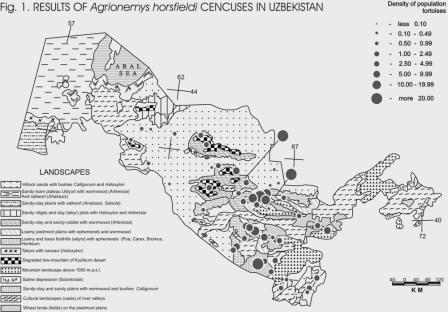Scientific activity
One of the main goals is the development of methods of keeping the Horsfield’s tortoise, Agrionemy horsfieldii, in captivity on the basis of data obtained from the wild. The typical feature is that the scientific studies are in close tie with the production process. The latest achievements of both local and foreign specialists are immediately adopted. Based on our own findings we have developed diets for the Horsfield’s tortoise, taking into account their age and seasons. We designed enclosures for incubation of eggs and cultivation of juveniles. We mastered the technology of collection and incubation of eggs. The young tortoises are reared from birth to maturity; the duration of this period has been significantly reduced. The brood stock regularly giving birth to offspring is maintained in semi-free conditions in the territory of the Zoocomplex.
A group of tortoises reared and ranched in artificial conditions has been studied for seven years. Our observations confirm the fact that in artificial conditions the tortoises reach sexual maturity significantly earlier than in artificial conditions, at the age of 3-4 years (against 10-13 in the wild). The sexual behavior and oviposition were monitored in this group. At the age of five years the females laid embryonate eggs, from which healthy newly-born tortoises of an average size hatched.
An important aspect of the company activity is the scientific-research work. A complete cycle of breeding takes place at the Zoocomplex, from mating to the birth of newly-born tortoises, both in the open and closed enclosures.
Guidelines of the keeping of tortoises and prevention of diseases were developed.
The results of the rearing and ranching of tortoises are regularly reported at the international conferences, to which the associates of the Zoocomplex Ltd are annually invited; besides, they are described in scientific articles:
Thus, conditions for a successful breeding of the Horsfield’s tortoise, Agrionemys horsfieldii, have been created in the artificial conditions of the Zoocomplex. The result is the development and realization of the ranching program of Agrionemys horsfieldii in Uzbekistan.
|
|
|
|
|
| Eggs
|
hatching
|
Twins
|
7 years old ranched tortoises
|
|---|
Field studies
The representatives of CITES bodies, in common with the associates of the Zoocomplex, carry out evaluations of tortoise populations in areas of their long-term exploitation. On average, the density of populations of this species reaches 0,5-2,0 individuals per ha, in some places 43 individuals per ha, depending on conditions in habitats (Bondarenko et al., 2000). The overall expert estimate of this numbers of this species in the plain land has been established at more than 20 million individuals, while the total numbers may reach 30 million individuals.
For many years, the Zookompleks LTD has been carrying out its own counts and monitoring of numbers of the Horsfield’s tortoise, in which both Russian (the Society for Protection of Amphibians and Reptiles, Moscow, Russia) and foreign experts (France) are involved. The results of these studies are published in the following works:
Bondarenko D.A., Peregontsev E.A. Distribution of the Horsfield’s tortoise in natural and anthropogenic landscapes of southern Uzbekistan. The Bulletin of the Moscow Society of Naturalists. Vol. 3, issue 2, 2006.
Вernard Devaux La tortue des steppes. La Tortue, No 78, p.54-75, 2007.
Вernard Devaux , a well-known herpetologist and the eminent specialist in this species of animals, on the invitation of the associates of the Zoocomplex visited the nursery and took part in the field trip organized by this organization for the study of this species in natural environments and counts of numbers in areas where the catches were planned.
Data obtained resulting from this field trip again confirmed the fact that the numbers of this tortoise species do not fluctuate significantly under natural conditions and remain stable for a long time, if conditions do not change. This peculiarity of the dynamics enables the comparison of the data of counts obtained over different years and assessment of the state of the population over a large area.
A map of distribution of tortoises in natural-territorial complexes of southern Uzbekistan was compiled on the basis of long-term counts (Bondarenko, Peregontsev, 2006, fig. 1).
Thus, in the long-term aspect the numbers of the Horsfield’s tortoise in Uzbekistan are stable and the reproductive potential is quite high.




